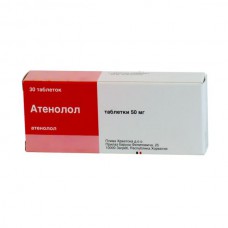Expiration date: 10/2026
Composition
Active substance: atenolol - 50,0 mg
Pharmacotherapeutic group
Beta1-blocker selective
Pharmacological action
It has antianginal, antihypertensive and antiarrhythmic action. Has no membrane stabilizing and intrinsic sympathomimetic activity. Reduces catecholamines stimulated the formation of cyclic adenosine monophosphate (camp) from adenosine triphosphate (ATP), reduce intracellular calcium ion current. In the first 24 h after ingestion of the decline in cardiac output marked reactive increase in total peripheral resistance of vessels which within 1-3 days gradually comes back to its original state and then gradually decreases. The antihypertensive effect associated with a decrease in minute volume of blood, decreased activity of the renin-angiotensin-aldosterone system, sensitivity of baroreceptors and influence on the Central nervous system. The antihypertensive effect is manifested as a decrease in systolic and diastolic blood pressure (BP), a decrease of stroke and minute blood volume. In the medium therapeutic doses has no effect on the tone of peripheral arteries. The antihypertensive effect lasts 24 hours, with regular use stabiliziruemost to the end of the second week of treatment. Antianginalny effect is determined by the requirements decrease myocardial oxygen due to reduction in heart rate (lengthening of diastole and improved myocardial perfusion) and contractility, as well as decreased sensitivity of the myocardium to the effects of sympathetic stimulation. Slows the heart rate (HR) at rest and during exercise. By increasing end-diastolic pressure in the left ventricle and increase the tension of the muscle fibers of the ventricles can increase oxygen demand, especially in patients with chronic heart failure. Antiarrhythmic effect is suppression of sinus tachycardia and is associated with the elimination of arrhythmogenic sympathetic effects on the conducting system of the heart, reducing the velocity of propagation of excitation through the sinoatrial node and the lengthening of the refractory period. Inhibits the conduction of impulses in the antegrade and to a lesser extent in the retrograde directions through the AV (atrioventricular) node and for additional ways of carrying out. Negative chronotropic effect manifested by 1 h after ingestion, reaches its maximum after 2-4 h, until 24 h. Reduces the automaticity of sinus node, slows heart rate, slows down AV conduction, reduces myocardial contractility, reduces the need of myocardium in oxygen. Reduces the excitability of the myocardium. When used in the medium therapeutic doses it has a less pronounced effect on smooth muscles of the bronchi and peripheral arteries than non-selective beta-blockers. Increases the survival rate of patients after a myocardial infarction (reduces frequency of development of ventricular arrhythmias and attacks of stenocardia). Practically does not weaken the effect bronhodilatiruyuschee of isoprenaline. Unlike nonselective beta-blockers when administered in high therapeutic doses has a less pronounced effect on bodies containing beta2-adrenergic receptors (pancreas, skeletal muscle, smooth muscles of peripheral arteries, bronchi and uterus), and on carbohydrate metabolism. To a lesser extent has a negative batmo-, Chrono-, Ino - and Chrono dromotroponoe effect. When used in high doses (more 100 mg/day.) it has a blocking effect on both subtypes of beta-adrenergic receptors.
Indications for use
Hypertension, prophylaxis of angina (except prinzmetals angina), heart rhythm disorders: sinus tachycardia, supraventricular tachyarrhythmia prevention, ventricular extrasystoles.
Contraindications
Hypersensitivity to the drug, cardiogenic shock, atrioventricular (AV) blockade II-III. (without an artificial pacemaker of the heart), bradycardia (heart rate less than 60 beats/min), syndrome weakness of the sinus node, sinoatrial block, acute or chronic heart failure decompensation, cardiomegaly without signs of heart failure, Prinzmetal's angina, arterial hypotension (in the case of myocardial infarction, systolic BP less than 100 mm Hg.St.), breastfeeding, concomitant use of monoamine oxidase inhibitors (MAO), the age of 18 years (the efficacy and safety of the drug is not installed). Severe forms of bronchial asthma and chronic obstructive pulmonary disease (COPD), a history of pheochromocytoma (without the simultaneous application of ?-blockers), severe violations of peripheral blood circulation. Precautions for use: diabetes mellitus (may mask symptoms of hypoglycemia), hypoglycemia, metabolic acidosis, conducting desensitizing therapies, chronic obstructive pulmonary disease, bronchospasm (history), AV blockade of I degree, chronic heart failure (compensated), peripheral circulatory disorders, pheochromocytoma (with concurrent use of alpha-blockers), liver failure, myasthenia gravis, hyperthyroidism, depression (including in history), psoriasis, advanced age, pregnancy, surgery.
Method of application and doses
Assign inside before eating, not liquid, squeezed small amount of liquid.
Hypertension. Treatment starts with 50 mg of Atenolol 1 per day. To achieve a stable antihypertensive effect requires 1 to 2 weeks of admission. The lack of symptoms antihypertensive effect dose increase to 100 mg at one time. Further dose increase is not recommended, as it is not accompanied by an increased therapeutic effect.
In ischemic heart disease, tahisistoliceskih cardiac arrhythmias -50 mg 1 time per day.
Angina. The initial dose is 50 mg per day. If during the week not achieved the optimal therapeutic effect, increase the dose to 100 mg a day. Elderly patients and patients with impaired renal excretory function require correction of dosing regimen. In the presence of renal insufficiency recommend dose adjustment depending on creatinine clearance. In patients with renal impairment when the values of creatinine clearance above 35 ml/min/1,73m2 (normal values are 100-150 ml/min/1.73 m2), significant accumulation of atenolol occurs. Patients, in gemodialise, appoint Atenolol 25 or 50 mg/day immediately after each dialysis, which should be carried out in stationary conditions, as may occur decrease in blood pressure. In elderly patients the initial single dose - 25 mg (can be increased under control of blood pressure, heart rate). Increasing the daily dose over 100 mg is not recommended, as the therapeutic effect amplifies, and the probability of development of side effects increases.
Release form
Tablets, film-coated 50 mg 30 tablets per pack.


